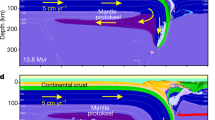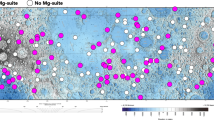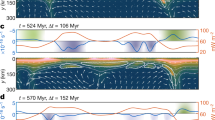Abstract
Cratons, the ancient nuclei of continents that have been stable for billions of years, are underlain by keels of lithosphere with strongly melt-depleted compositions1,2. These cratonic keels may have formed either from partial melting in a mantle-plume environment3,4, or alternatively by melting at shallow depths in a subduction zone, during the successive accretion of slabs of oceanic lithosphere5. The stability of cratonic keels has been attributed to a pervasive state of near-neutral buoyancy—isopycnicity—created by offsetting thermal and compositional effects on density6. However, it is unclear how an isopycnic state can be sustained over geological time2. Here we simulate the evolution of a simplified southern African cratonic keel, initiated in either a hot-plume or a cold-slab environment, over 3 billion years, using a numerical model that incorporates secular cooling of the mantle, coupled with gradual loss of radiogenic heating in the lithosphere. We find that the simulation that starts from a cold-slab environment best explains the subsidence history of the southern African craton7. However, irrespective of how the cratonic keel formed, we find that the isopycnic state is inherently ephemeral: a cratonic keel that is approximately isopycnic under present conditions was more, or less, buoyant in the geologic past.
This is a preview of subscription content, access via your institution
Access options
Subscribe to this journal
Receive 12 print issues and online access
$259.00 per year
only $21.58 per issue
Buy this article
- Purchase on Springer Link
- Instant access to full article PDF
Prices may be subject to local taxes which are calculated during checkout




Similar content being viewed by others
References
Eaton, D. W. et al. The elusive lithosphere–asthenosphere boundary beneath cratons. Lithos 109, 1–22 (2009).
Lee, C-T., Luffi, P. & Chin, E. J. Building and destroying continental mantle. Ann. Rev. Earth Planet. Sci. 39, 59–90 (2011).
Griffin, W. L. et al. The origin and evolution of Archean lithospheric mantle. Precambr. Res. 127, 19–41 (2003).
Arndt, N. T. et al. Origin of Archean subcontinental lithospheric mantle: Some petrological constraints. Lithos 109, 61–71 (2009).
Helmstaedt, H. H. & Schulze, D. J. Southern African kimberlites and their mantle sample: Implications for Archean tectonics and lithosphere evolution. Geol. Soc. Aust. Spec. Publ. 14, 358–68 (1989).
Jordan, T. H. Structure and formation of the continental tectosphere. J. Petrol. 1, 11–37 (1988).
Coward, M. P., Spencer, R. M. & Spencer, C. E. Development of the Witwatersrand Basin, South Africa. Spec. Pub. Geol. Soc. Lond. 96, 243–269 (1995).
Artemieva, I. M. The continental lithosphere: Reconciling thermal, seismic, and petrologic data. Lithos 109, 23–46 (2009).
Fischer, K. M. et al. The lithosphere–asthenosphere boundary. Ann. Rev. Earth Planet. Sci. 38, 551–575 (2010).
Yuan, H. & Romanowicz, B. Lithospheric layering in the North American craton. Nature 466, 1063–1069 (2010).
Peslier, A. H. et al. Olivine water contents in the continental lithosphere and the longevity of cratons. Nature 467, 78–83 (2010).
Flowers, R. M., Royden, L. J. & Bowring, S. A. Isostatic constraints on the assembly, stabilization, and preservation of cratonic lithosphere. Geology 32, 321–324 (2004).
Cooper, C. M., Lenardic, A. & Moresi, L. The thermal structure of stable continental lithosphere within a dynamic mantle. Earth Planet. Sci. Lett. 222, 807–817 (2004).
Lenardic, A. & Moresi, L-N. Some thoughts on the stability of cratonic lithosphere: Effects of buoyancy and viscosity. J. Geophys. Res. 104, 12747–12758 (1999).
Beuchert, M. J., Podladchikov, Y. Y., Simond, N. S. C. & Rüpke, L. H. Modelling of craton stability using a viscoelastic rheology. J. Geophys. Res. 115, B11413 (2010).
James, D. E. et al. Tectospheric structure beneath southern Africa. Geophys. Res. Lett. 28, 2485–2488 (2001).
Perry, H. K. C., Mareschal, J-C. & Jaupart, C. Variations of strength and localized deformation in cratons: the 1.9 Ga Kapuskasing uplift, Superior Province, Canada. Earth Planet. Sci. Lett. 249, 216–228 (2006).
Mareschal, J. C. et al. Heat flow and deep thermal structure near the southeastern edge of the Canadian Shield. Can. J. Earth Sci. 37, 399–414 (2000).
Perry, H. K. C. et al. Crustal heat production in the superior province, Canadian shield, and in North America inferred from heat flow data. J. Geophys. Res. 111, B04401 (2006).
Jaupart, C. & Mareschal, J.-C. The thermal structure and thickness of continental roots. Lithos 48, 93–114 (1999).
Katsura, T. et al. Adiabatic temperature profile in the mantle. Phys. Earth Planet. Int. 183, 212–218 (2010).
Michaut, C., Jaupart, C. & Mareschal, J-C. Thermal evolution of cratonic roots. Lithos 109, 47–60 (2009).
Korenaga, J. & Karato, S.-L. A new analysis of experimental data on olivine rheology. J. Geophys. Res. 113, B02403 (2008).
Bokelmann, G. & Silver, P. Shear stress at the base of shield lithosphere. Geophys. Res. Lett. 29, 6-1–6-4 (2002).
Hirth, G., Evans, R. L. & Chave, A. D. Comparison of continental and oceanic mantle electrical conductivity: Is the Archean lithosphere dry? Geochem. Geophys. Geosystems 1, 2000GC000048 (2000).
Kennedy, C. S. & Kennedy, G. C. The equilibrium boundary between graphite and diamond. J. Geophys. Res. 81, 2467–2470 (1976).
Eaton, D. W. & Darbyshire, F. Tectonic architecture and lithospheric evolution of the Hudson Bay region. Tectonosphysics 480, 1–22 (2010).
Shirey, S. B. et al. Diamond genesis, seismic structure, and evolution of the Kaapvaal–Zimbabwe craton. Science 297, 1683–1686 (2002).
Stachel, T. & Harris, J. W. The origin of cratonic diamonds—Constraints from mineral inclusions. Ore Geol. Rev. 34, 5–32 (2008).
Jones, A. G., Evans, R. L. & Eaton, D. W. Velocity-conductivity relationships for mantle mineral assemblages in Archean cratonic lithosphere based on extremal bounds. Lithos 109, 131–143 (2009).
Acknowledgements
This work was supported by the Natural Sciences and Engineering Research Council of Canada.
Author information
Authors and Affiliations
Contributions
Both authors contributed extensively to the work presented in this paper. D.W.E. wrote the simulation code, ran the model and wrote the manuscript. H.K.C.P. edited the manuscript and provided conceptual advice.
Corresponding author
Ethics declarations
Competing interests
The authors declare no competing financial interests.
Rights and permissions
About this article
Cite this article
Eaton, D., Claire Perry, H. Ephemeral isopycnicity of cratonic mantle keels. Nature Geosci 6, 967–970 (2013). https://doi.org/10.1038/ngeo1950
Received:
Accepted:
Published:
Issue Date:
DOI: https://doi.org/10.1038/ngeo1950
This article is cited by
-
Deep continental roots and cratons
Nature (2021)
-
Building cratonic keels in Precambrian plate tectonics
Nature (2020)
-
Modification of the Western Gondwana craton by plume–lithosphere interaction
Nature Geoscience (2018)
-
Earth tectonics as seen by GOCE - Enhanced satellite gravity gradient imaging
Scientific Reports (2018)
-
Cratonic root beneath North America shifted by basal drag from the convecting mantle
Nature Geoscience (2015)



